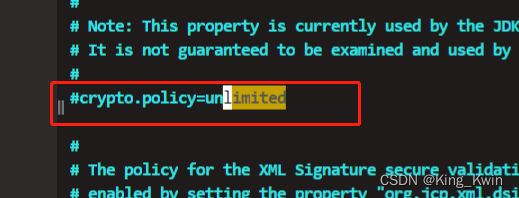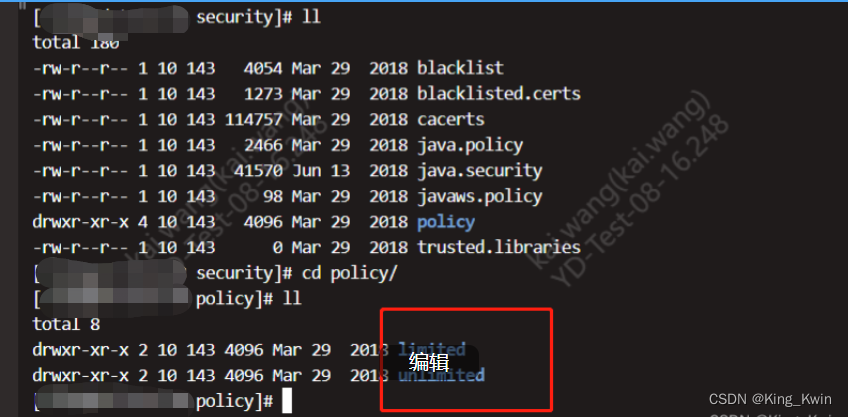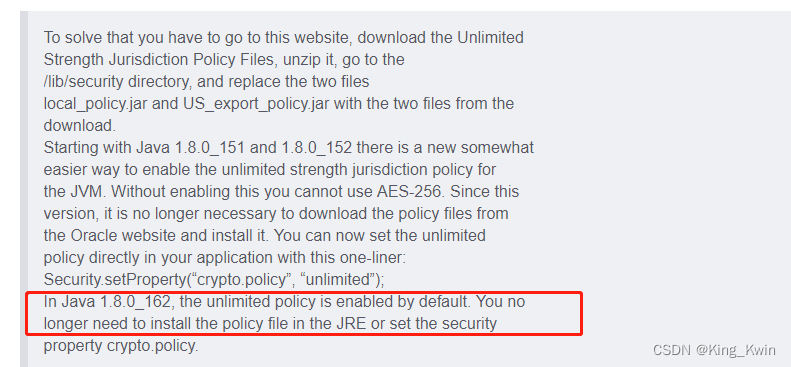当前业界敏感信息加密使用AES较多,GCM模式兼具效率和安全性,故选择使用该模式。
注意
我们经常使用256位秘钥,因为美国的安全管控,jdk8的较老版本安全策略不支持256位秘钥,需替换jdk\jre\lib\security 下的安全策略文件local_policy.jar 和US_export_policy.jar
java 1.8.0_151到1.8.0_161版本已经包含了不同的安全策略,需要修改jdk\jre\lib\security\java.security 文件,放开crypto.policy=unlimited的限制即可,这个配置决定选择policy目录下的unlimited或limited的策略文件;


java 1.8.0_162版本后默认crypto.policy=unlimited 则不需修改。

代码实现
package com.kwin.demo.api.util;
import org.apache.commons.codec.binary.Base64;
import javax.crypto.Cipher;
import javax.crypto.KeyGenerator;
import javax.crypto.SecretKey;
import javax.crypto.SecretKeyFactory;
import javax.crypto.spec.GCMParameterSpec;
import javax.crypto.spec.PBEKeySpec;
import javax.crypto.spec.SecretKeySpec;
import java.nio.charset.StandardCharsets;
import java.security.NoSuchAlgorithmException;
import java.security.SecureRandom;
import java.security.spec.InvalidKeySpecException;
import java.security.spec.KeySpec;
/**
* @author kwin
* @Date 2022/7/13 16:20
**/
public class AESUtil {
private static final String KEY_ALGORITHM = "AES";
private static final String CIPHER_ALGORITHM = "AES/GCM/NoPadding";
private static final int TAG_LENGTH_BIT = 128;
private static final int IV_LENGTH_BYTE = 12;
private static final int SALT_LENGTH_BYTE = 16;
private static final int AES_KEY_BIT = 256;
/**
* 安全随机数生成
* @param numBytes
* @return
*/
public static byte[] getRandomNonce(int numBytes) {
byte[] nonce = new byte[numBytes];
new SecureRandom().nextBytes(nonce);
return nonce;
}
/**
* 生成盐值
* @return
*/
public static String generateSalt() {
byte[] salt = getRandomNonce(SALT_LENGTH_BYTE);
return Base64.encodeBase64String(salt);
}
/**
* 生成初始向量
* @return
*/
public static String generateIv() {
byte[] iv = getRandomNonce(IV_LENGTH_BYTE);
return Base64.encodeBase64String(iv);
}
/**
* 生成256位秘钥
* @return
* @throws NoSuchAlgorithmException
*/
public static SecretKey getAESKey() throws NoSuchAlgorithmException {
KeyGenerator keyGen = KeyGenerator.getInstance(KEY_ALGORITHM);
keyGen.init(AES_KEY_BIT, SecureRandom.getInstanceStrong());
return keyGen.generateKey();
}
/**
* 生成256位秘钥,base64编码
* @return
* @throws NoSuchAlgorithmException
*/
public static String generateAESKey() throws NoSuchAlgorithmException {
return Base64.encodeBase64String(getAESKey().getEncoded());
}
/**
* 通过密码和盐值生成256位aes秘钥
* @param password 密码
* @param salt 盐值
* @return
* @throws NoSuchAlgorithmException
* @throws InvalidKeySpecException
*/
public static SecretKey getAESKeyFromPassword(char[] password, byte[] salt)
throws NoSuchAlgorithmException, InvalidKeySpecException {
SecretKeyFactory factory = SecretKeyFactory.getInstance("PBKDF2WithHmacSHA256");
// iterationCount = 65536
KeySpec spec = new PBEKeySpec(password, salt, 65536, AES_KEY_BIT);
SecretKey secret = new SecretKeySpec(factory.generateSecret(spec).getEncoded(), KEY_ALGORITHM);
return secret;
}
/**
* 加密
* @param source 明文
* @param secret 秘钥
* @param iv 初始向量
* @return
* @throws Exception
*/
public static byte[] encrypt(byte[] source, SecretKey secret, byte[] iv) throws Exception {
Cipher cipher = Cipher.getInstance(CIPHER_ALGORITHM);
cipher.init(Cipher.ENCRYPT_MODE, secret, new GCMParameterSpec(TAG_LENGTH_BIT, iv));
byte[] encryptedText = cipher.doFinal(source);
return encryptedText;
}
/**
* 加密,base64编码
* @param source 明文
* @param key 秘钥
* @param iv 初始向量
* @return
* @throws Exception
*/
public static String encrypt(String source, String key, String iv) throws Exception {
SecretKey secretKey = new SecretKeySpec(Base64.decodeBase64(key), KEY_ALGORITHM);//getAESKeyFromPassword(password.toCharArray(), Base64.decodeBase64(salt));
byte[] encryptedText = encrypt(source.getBytes(StandardCharsets.UTF_8), secretKey, Base64.decodeBase64(iv));
return Base64.encodeBase64String(encryptedText);
}
/**
* 加密,通过base64编码,秘钥通过password和盐值生成
* @param source 明文
* @param password 密码
* @param iv 初始向量
* @param salt 盐值
* @return
* @throws Exception
*/
public static String encrypt(String source, String password, String iv, String salt) throws Exception {
SecretKey secretKey = getAESKeyFromPassword(password.toCharArray(), Base64.decodeBase64(salt));
byte[] encryptedText = encrypt(source.getBytes(StandardCharsets.UTF_8), secretKey, Base64.decodeBase64(iv));
return Base64.encodeBase64String(encryptedText);
}
/**
* 解密
* @param encryptBytes 加密数组
* @param secret 秘钥
* @param iv 初始向量
* @return
* @throws Exception
*/
public static String decrypt(byte[] encryptBytes, SecretKey secret, byte[] iv) throws Exception {
Cipher cipher = Cipher.getInstance(CIPHER_ALGORITHM);
cipher.init(Cipher.DECRYPT_MODE, secret, new GCMParameterSpec(TAG_LENGTH_BIT, iv));
byte[] plainText = cipher.doFinal(encryptBytes);
return new String(plainText, StandardCharsets.UTF_8);
}
/**
* 解密
* @param encryptStr 加密字符串
* @param password 密码
* @param iv 初始向量
* @param salt 盐值
* @return
* @throws Exception
*/
public static String decrypt(String encryptStr, String password, String iv, String salt) throws Exception {
SecretKey secretKey = getAESKeyFromPassword(password.toCharArray(), Base64.decodeBase64(salt));
return decrypt(Base64.decodeBase64(encryptStr), secretKey, Base64.decodeBase64(iv));
}
/**
* 解密
* @param encryptStr 加密字符串
* @param key 秘钥
* @param iv 初始向量
* @return
* @throws Exception
*/
public static String decrypt(String encryptStr, String key, String iv) throws Exception {
SecretKey secretKey = new SecretKeySpec(Base64.decodeBase64(key), KEY_ALGORITHM);
return decrypt(Base64.decodeBase64(encryptStr), secretKey, Base64.decodeBase64(iv));
}
}
pom依赖
<!-- https://mvnrepository.com/artifact/commons-codec/commons-codec -->
<dependency>
<groupId>commons-codec</groupId>
<artifactId>commons-codec</artifactId>
<version>1.15</version>
</dependency>
<!-- https://mvnrepository.com/artifact/commons-collections/commons-collections -->
<dependency>
<groupId>commons-collections</groupId>
<artifactId>commons-collections</artifactId>
<version>3.2.2</version>
</dependency>
<!-- https://mvnrepository.com/artifact/org.apache.commons/commons-lang3 -->
<dependency>
<groupId>org.apache.commons</groupId>
<artifactId>commons-lang3</artifactId>
<version>3.12.0</version>
</dependency>




















 423
423











 被折叠的 条评论
为什么被折叠?
被折叠的 条评论
为什么被折叠?








